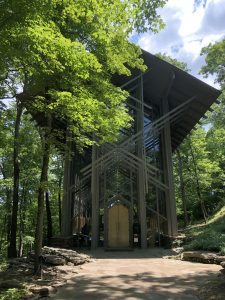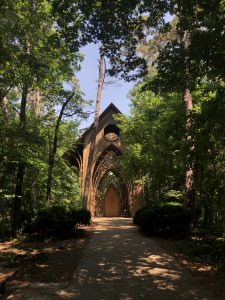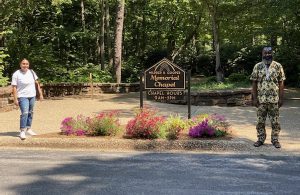Arianna Hilliard ’22, and Professor Adédoyin Tęríba
This summer, I worked alongside Professor Tęríba to create an Architectural Intensive course for the Spring 2022 semester. The intensive course is named Lines Intertwine: Fay Jones and the Architecture of the Ozarks and will focus on the works of the late architect E. Fay Jones.
We began this project by traveling to Arkansas to view Jones’ work. We visited the Thorncrown Chapel (1980) located in Eureka Springs, and the Mildred B. Cooper Memorial Chapel (1988) located in Bella Vista. During the trip, we discussed the structures and our findings to begin planning the intensive course. Much of our research was developed during the trip, as we could analyze the structures close up.
After returning, we created a syllabus and itinerary for the intensive course and trip to Arkansas. There were three main components to this process: discussing and analyzing the architecture we viewed on our trip, creating a trip itinerary, and creating a course syllabus that covers key components to studying Jones’ architecture. The trip to Arkansas includes visits to the Thorncrown Chapel, Mildred B. Cooper Memorial Chapel, several sites in the Garvan Woodland Gardens, and the Fay Jones archive at the University of Arkansas. Professor Tęríba and students will stay in Eureka Springs, Arkansas and Hot Springs, Arkansas, two towns full of historic architecture. The syllabus is meant to introduce four Vassar students to Jones’ work in theory and in-situ i.e. visiting the structures in their settings.
This project highlighted the importance of experiencing architecture in its truest and most concrete form and looking through the lens of an architect to analyze their process; my understanding of E. Fay Jones’ architectural work grew immensely. This experience allowed us to create a course that will encourage students to immerse themselves within Jones’ work and begin to understand his process of designing architecture.



